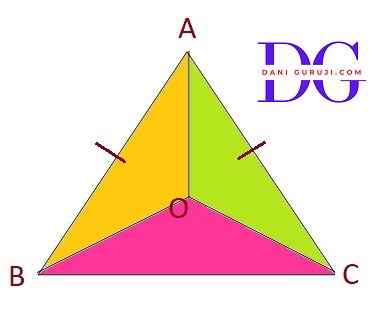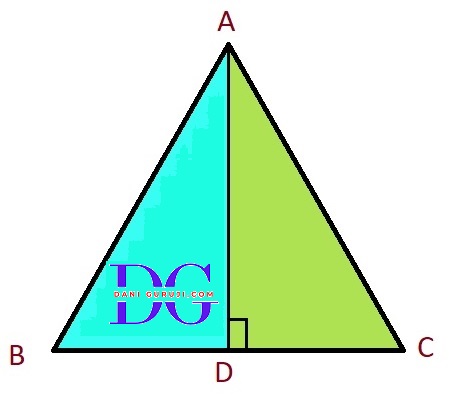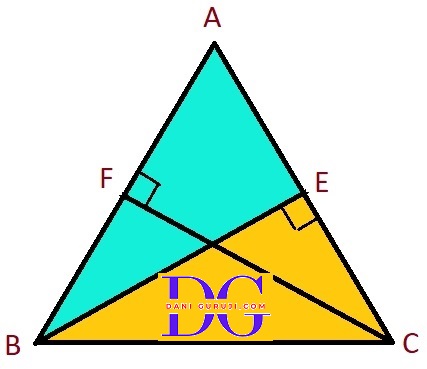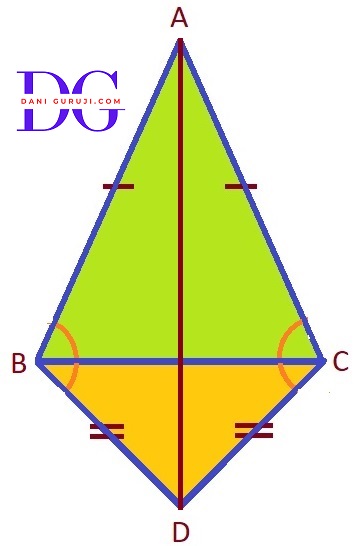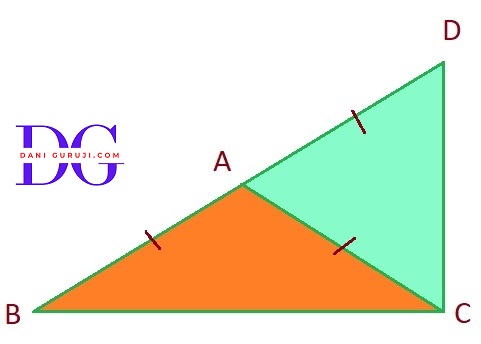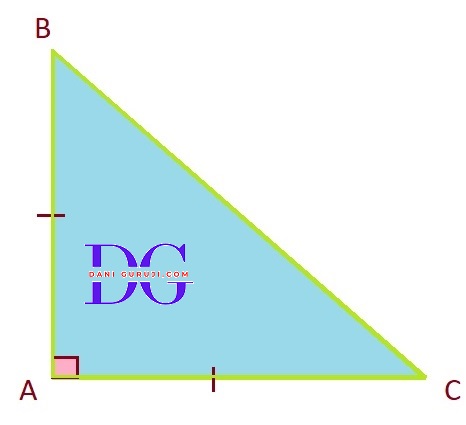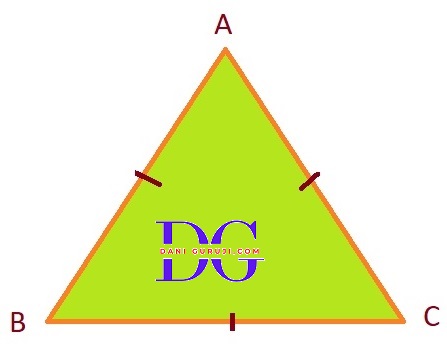In an isosceles triangle ABC, with AB = AC, the bisectors of $\angle $B and $\angle $C intersect each other at O. Join A to O. Show that:
(i) OB = OC
(ii) AO bisects $\angle $A
Solution :
It is given information that in triangle ABC is isosceles with AB = AC .
(i): Proof that OB = OC
Consider the triangles Δ ABC
⇒ AB = AC
( Given in the problem. )
⇒ $\angle $B = $\angle $C
( the angles opposite to these equal sides are also equal. )
Dividing both sides of equation by 2, we get :
⇒ ${ 1 \over 2} \angle $ B = $ { 1 \over 2} \angle $ C
Since BO and CO are the bisectors of $\angle $B and $\angle $C respectively, we have:
⇒ $\angle $ OBC = ${ 1 \over 2} \angle $ B
⇒ $\angle $ OCB = ${ 1 \over 2} \angle $ C
∴ $\angle $OBC = $\angle $OCB.
( As ${ 1 \over 2} \angle $ B = $ { 1 \over 2} \angle $ C. Angle bisectors)
Consider the triangles Δ OBC
OB = OC
( Since $\angle $OBC = $\angle $OCB, the sides opposite to these equal angles must also be equal. The side opposite to $\angle $OBC is OC, and the side opposite to $\angle $OCB is OB. )
(ii) AO bisects $\angle $A
Consider the triangles Δ ABO and Δ ACO
⇒ AB = AC
( Given in the problem. )
⇒ OB = OC
( Proved in part i )
⇒ AO = AO
( This is a common side for both triangles. )
∴ ΔABO $\cong$ ΔACO
( by the SSS congruence rule. )
Since the triangles are congruent, We know that, Corresponding parts of congruent triangles are equal. Therefore,
⇒ $\angle $BAO = $\angle $CAO
∴ AO bisects $\angle $A
In ΔABC, AD is the perpendicular bisector of BC (see Fig). Show that ΔABC is an isosceles triangle in which AB = AC.
Solution :
From given figure, It is given that
AD is the perpendicular bisector of BC. This means that
$\angle $ADB = $\angle $ADC = 90°
AD bisects BC, so BD = CD
Consider the triangles Δ ABD and Δ ACD
⇒ BD = CD
( Given, since AD is the bisector of BC. )
⇒ $\angle $ADB = $\angle $ADC
( Both are 90°. )
⇒ AD = AD
( Common side to both triangles. )
∴ ΔABD $\cong$ ΔACD
( by the SAS congruence rule. )
Since the two triangles are congruent, their corresponding parts must be equal
AB = AC. (By C.P.C.T.)
By definition, a triangle with two equal sides is an isosceles triangle. Since we have shown that
AB = AC, △ABC is an isosceles triangle.
ABC is an isosceles triangle in which altitudes BE and CF are drawn to equal sides AC and AB respectively see Fig. Show that these altitudes are equal.
Solution :
From given figure, It is given that
△ABC is an isosceles triangle with AB = AC
BE is an altitude to side AC, which means = $\angle $BEC = 90°
CF is an altitude to side AB, which means = $\angle $CFB = 90°
Consider the triangles Δ EBC and Δ FCB
⇒ BC = CB
( Common side to both triangles. )
⇒ $\angle $BEC = $\angle $CFB
( Both are 90°. )
⇒ $\angle $EBC = $\angle $FCB
( Since AB = AC, the angles opposite to these sides are equal, so. $\angle $ABC = $\angle $ACB. This means $\angle $EBC = $\angle $FCB )
∴ ΔEBC $\cong$ ΔFCB
( by the AAS congruence rule. )
Since the two triangles are congruent, their corresponding parts must be equal
BE = CF. (By C.P.C.T.)
ABC is a triangle in which altitudes BE and CF to sides AC and AB are equal. Show that
(i)ΔABE $\cong$ Δ ACF
(ii) AB = AC, i.e., ABC is an isosceles triangle
Solution :
From given figure, It is given that
Altitudes, BE = CF,
CF is an altitude to side AB, which means = $\angle $AFC = 90°
BE is an altitude to side AC, which means = $\angle $ AEB = 90°
Consider the triangles ΔABE and Δ ACF
⇒ BE = CF
( Given that the altitudes are equal. )
⇒ $\angle $AFC = $\angle $ AEB
( Both are 90°. )
⇒ $\angle $BAE = $\angle $CAF
( they are the same angle, $\angle $A )
∴ ΔABE $\cong$ Δ ACF
( by the AAS congruence rule. )
Since the two triangles are congruent, their corresponding parts must be equal
AB = AC (By C.P.C.T.)
A triangle with two equal sides is defined as an isosceles triangle.
Since we have shown that AB = AC, it follows that △ABC is an isosceles triangle.
ABC and DBC are two isosceles triangles on the same base BC (see fig.). Show that
$\angle $ABD = $\angle $ACD
Solution :
Let us join AD
Consider the triangles ΔABD and Δ ACD,
⇒ AB = AC
( Given that △ABC is an isosceles triangle with base BC. )
⇒ DB = DC
( Given that △DBC is an isosceles triangle with base BC. )
⇒ AD = AD
( This is a common side for both triangles )
∴ ΔABD $\cong$ Δ ACD
( by the SSS congruence rule. )
Since the two triangles are congruent, their corresponding parts must be equal
$\angle $ ABD = $\angle $ACD. (By C.P.C.T.)
ΔABC is an isosceles triangle in which AB = AC. Side BA is produced to D such that AD = AB (see fig.). Show that $\angle $BCD is a right angle.
Solution :
From given figure, It is given that
△ABC is an isosceles triangle with AB = AC
Side BA is extended to point D
AD = AB
Consider the triangles ΔABC
⇒ AB = AC
( Given that △ABC is an isosceles triangle with base BC. )
⇒ $\angle $ACB = $\angle $ABC -------( equation 1)
( the angles opposite to these equal sides must also be equal. )
Consider the triangles ΔACD,
⇒ AD = AB
( Given in problem statement )
We also know that AB = AC
Therefore, by the transitive property of equality,
AD = AC.
This means that △ACD is also an isosceles triangle with AD = AC
$\angle $ACD = $\angle $ADC -------( equation 2)
( the angles opposite to these equal sides must also be equal. )
Apply the Angle Sum Property of a Triangle
Consider the triangles ΔBCD
⇒ $\angle $BCD + $\angle $CDB + $\angle $CBD = 180°.
( The sum of the angles in any triangle is 180°. )
We also know that
$\angle $BCD = $\angle $ ACB + $\angle $ACD -------( equation 3)
And, $\angle $CDB = $\angle $ADC
∴ $\angle $ADC = $\angle $ACD
( from equation 2 )
And, $\angle $CBD = $\angle $ABC
∴ $\angle $ABC = $\angle $ACB
( from equation 1 )
Substitute these values into the angle sum equation:
( $\angle $ ACB + $\angle $ACD )+ $\angle $ACD + $\angle $ACB = 180°
$\angle $BCD + $\angle $BCD = 180°
( from equation 3 )
2 $\angle $BCD = $ { 180° }$
$\angle $BCD = $ { 180° \over 2}$
$\angle $BCD = $ { 90° }$
Therefore, $\angle $BCD is a right angle.
ABC is a right angled triangle in which $\angle $A = 90° and AB = AC. Find $\angle $B and $\angle $C.
Solution :
It is given that
△ABC is an isosceles triangle with AB = AC
$\angle $A = 90°
Consider the triangles ΔABC
Apply the Angle Sum Property of a Triangle
⇒ $\angle $A + $\angle $B + $\angle $C = 180°.
( The sum of the angles in any triangle is 180°. )
⇒ 90° + $\angle $B + $\angle $C = 180°.
⇒ $\angle $B + $\angle $C = 180° - 90°
⇒ $\angle $B + $\angle $C = 90°
Since we know that $\angle $B = $\angle $C
( Since the triangle is isosceles with AB = AC, the angles opposite to these equal sides must also be equal. )
Substitute these values into the angle sum equation:
90° + $\angle $B + $\angle $B = 180°.
2 $\angle $B = $ { 180° - 90° }$
$\angle $B = $ { 90° \over 2}$
$\angle $B = $ { 45° }$
Since $\angle $B = $\angle $C, we also have:$\angle $C = 45°
Thus, in the given triangle $\angle $B = 45° , $\angle $C = 45°
Show that the angles of an equilateral triangle are 60° each.
Solution :
Let's consider a triangle, △ABC, where AB = BC = CA.
Since we know that AB = BC
( the angles opposite to these sides must be equal.)
⇒ $\angle $A = $\angle $C
Since we know that BC = CA
( the angles opposite to these sides must be equal.)
⇒ $\angle $A = $\angle $B
From the above, we can conclude that all three angles are equal:
$\angle $A = $\angle $B = $\angle $C
Apply the Angle Sum Property of a Triangle
⇒ $\angle $A + $\angle $B + $\angle $C = 180°.
( The sum of the angles in any triangle is 180°. )
⇒ 3$\angle $A = 180°
( Since all three angles are equal, we can substitute $\angle $A for $\angle $B and $\angle $C: )
⇒ $\angle $A = $ { 180° \over 3}$
⇒ $\angle $A = $ { 60° }$
Since $\angle $A = $\angle $B = $\angle $C, all three angles are 60° each.
Syllabus for class 10
Advanced courses and exam preparation.
Previous Year Paper
Advanced courses and exam preparation.
Mock Test
Explore programming, data science, and AI.
